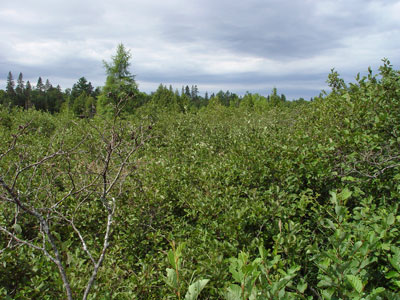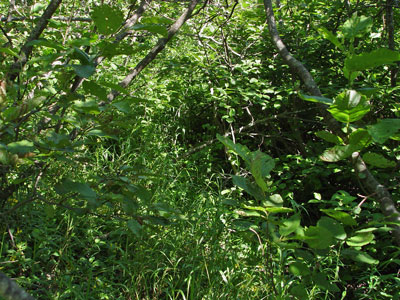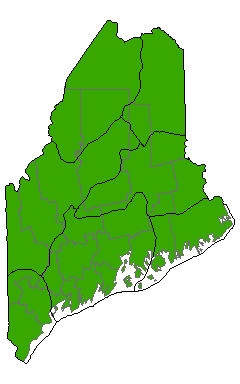DACF Home → Bureaus & Programs → Maine Natural Areas Program → Communities, Plants, and Animals → Natural Community Fact Sheets → Alder Thicket
Printer Friendly Fact Sheet - 1 MB pdf (Get a free copy of Adobe Acrobat Reader)
Alder Thicket
Scientific Name: Alder Shrub Thicket; State Rank: S5

- Community Description
- Soil and Site Characteristics
- Diagnostics
- Similar Types
- Conservation, Wildlife and Management Considerations
- Distribution
- Characteristic Plants
- Associated Rare Plants
- Associated Rare Animals
- Examples on Conservation Lands You Can Visit
Community Description: These tall (1-3 m) shrub dominated wetlands are characterized by dense growth of alder. Speckled alder is most typical, but rarely mountain alder or smooth alder may predominate. Red maple, gray birch, or other trees may be scattered sparsely above the shrubs. The herb layer is usually well developed (>35% cover), and is a variable mixture of forbs, graminoids, and ferns. The bryoid layer is patchy and dominated by peat mosses, especially Sphagnum girghensonii, S. palustre and S. magellanicum. Back to top.

Soil and Site Characteristics: This type occurs in basin wetlands that are usually saturated and may be seasonally flooded throughout the season. It is usually on muck or on peat. This type is very common as wet cleared areas revert to forest, such as old beaver meadows. Back to top.
Diagnostics: These are shrub-dominated wetlands on peat or muck soils, often only temporarily flooded, in which alders dominate and comprise >20% cover, usually >40%. Back to top.
Similar Types: Alder Floodplains occur on mineral soils along medium to large rivers rather than in basins Sedge Meadows, Tall Grass Meadows, and Grassy Shrub Marshes may have alder as a sub-dominant species, with lower cover than the graminoids. Tall Shrub Fens occur as part of a peatland and have mountain holly or heath shrubs mixed with the alder. Rivershore Shrub Thickets often contain alder, but it is sub-dominant. Back to top.
Conservation, Wildlife and Management Considerations: Well distributed and well replicated. Many examples occur on public lands and private conservation lands where no land use conflict exists. These shrublands, especially when they occur in close proximity to open water may, provide habitat for common bird species such as common yellowthroat, alder flycatcher, Wilson's warbler, and Lincoln's sparrow. Some occurrences of this community type support vernal pools, which are important breeding habitat for a variety of amphibians including wood frogs, spotted salamanders, and blue-spotted salamanders. Rare turtles like the wood turtle, or Blanding's and spotted turtles in southern Maine, may feed on amphibian egg masses present in such pools. Back to top.
Distribution: Statewide; extending in all directions from Maine. Landscape Pattern: Small to Large Patch. Back to top.


Characteristic Plants: These plants are frequently found in this community type. Those with an asterisk are often diagnostic of this community.
- Sapling/Shrub
- Balsam fir*
- Black spruce*
- Common blackberry*
- Gray birch*
- Hardhack*
- Meadowsweet
- Mountain alder*
- Red maple*
- Speckled alder*
- Herb
- Bluejoint*
- Cinnamon fern
- Flat-topped white aster*
- Royal fern
- Sensitive fern*
- Swamp dewberry*
- Three-seeded sedge
- Tussock sedge*
- Wild calla
- Bryoid
- Sphagnum mosses*
- Blanding's turtle
- Spotted turtle
- Wood turtle
Examples on Conservation Lands You Can Visit
| Example | County |
|---|---|
| Bigelow Preserve Public Lands | Somerset Co. |
| Bradley Wildlife Management Area | Penobscot Co. |
| Branch Lake Wildlife Management Unit | Hancock Co. |
| Kennebunk Plains Preserve | York Co. |
| Muddy River Wildlife Management Area | Sagadahoc Co. |
| Narraguagus Wildlife Management Unit | Washington Co. |
| Redington Pond Public Lands | Franklin Co. |